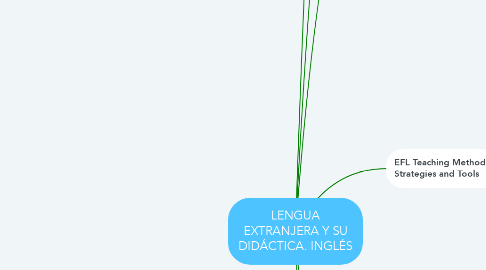
1. Basic Concepts
1.1. Types of language
1.1.1. Mother Tongue, Native Language or First Language (L1)
1.1.2. Second Language (L2)
1.1.3. Foreign Language (FL)
1.1.4. Additional Language (AL)
1.2. Teaching
1.2.1. Foreign language (TEFL)
1.2.2. Second language (TESL)
1.3. Bilingual person
1.3.1. Simultaneous
1.3.2. Additive
1.3.3. Subtractive
1.4. Types of learning
1.4.1. Deductive Learning
1.4.1.1. Students are taught rules and given specific information about a language.
1.4.2. Inductive Learning
1.4.2.1. Children are left to discover or induce rules from their experience of using the language.
1.5. Linguistic
1.5.1. Competence
1.5.1.1. speaker-hearers’ underlying knowledge of language.
1.5.2. Performance
1.5.2.1. Speaker-hearers’ actual use of language
1.6. Centered teaching
1.6.1. Teacher
1.6.1.1. Teacher controls teaching
1.6.2. Learner
1.6.2.1. Students have an activde role
1.7. Input vs Output
1.7.1. Input: Every piece of information that you receive.
1.7.2. Output: produce language.
1.8. Feedback
1.9. Negotiation of meaning
1.9.1. Negotiation of meaning is a process that speakers go through to reach a clear understanding of each other.
1.10. Four skills
1.10.1. Receptive or passive skills
1.10.1.1. Listening
1.10.1.2. Reading
1.10.2. Productive or active skills
1.10.2.1. Speaking
1.10.2.2. Writing
1.11. Communicative competence
1.11.1. Linguistic Competence
1.11.2. Discourse Competence
1.11.3. Sociolinguistic Competence
2. Child’s developmental process (3-6)
2.1. According to age have different evolution in...
2.1.1. Cognitive
2.1.2. Socio-affective and Personality
2.1.3. Psychomotor
2.1.4. Linguistic
3. Attitudes and motivation in L2 learning
3.1. Motivation
3.1.1. Move and Action
3.1.2. Desire to perform an action
3.1.3. Types
3.1.3.1. Intrinsic
3.1.3.1.1. Desire to participate in an activity merely for the pleasure derived from that activity.
3.1.3.2. Extrinsic
3.1.3.2.1. That is engaged in for the sake of a desirable outcome.
3.1.4. Related to behavior
3.1.5. Factors influencing motivation
3.1.5.1. Materials
3.1.5.2. Planning
3.1.5.3. Methodology
3.1.5.4. Teacher-student attitude
3.1.5.5. Teacher’s attitude
3.1.6. 4 stages in motivation (Zoltan Dörnyei (2001))
3.1.6.1. Create motivating conditions for learning
3.1.6.2. Introduce initial motivation techniques
3.1.6.3. Maintain motivation
3.1.6.4. Positive evaluation
4. EFL Teaching Methods, Strategies and Tools
4.1. Tools
4.1.1. Materials that are age-appropriate and adapted to their level
4.1.1.1. Realia (Stimulate)
4.1.1.2. Music (Motivate)
4.1.1.3. Videos (Attention)
4.1.1.4. Books
4.2. EFL Teaching strategies
4.2.1. Specifications, behaviors, steos or techniques
4.2.2. Types of strategies
4.2.2.1. Cognitive
4.2.2.2. Metacognitive
4.2.2.3. Memory-related
4.2.2.4. Compensatory
4.2.2.5. Affective
4.2.2.6. Social
4.2.3. Methods
4.2.3.1. Types
4.2.3.1.1. Grammar translation
4.2.3.1.2. Direct
4.2.3.1.3. Audio-Lingual
4.2.3.1.4. Communicative Language Teaching
4.2.3.1.5. Task based learning
4.2.3.1.6. Content based learning (CLIL)
4.2.3.1.7. Suggestopedia
4.2.3.1.8. Total physical response (TPR)
4.2.3.1.9. Phonics
5. Materials, games and ICTs in Early Childhood Education
5.1. Materials
5.1.1. Objects used in the classroom for learning
5.1.2. Types
5.1.2.1. Culturally relevant
5.1.2.2. Developmentally appropriate
5.1.2.3. Linked to
5.1.2.3.1. Children´s interests
5.1.2.3.2. Learning goals
5.2. ICT
5.2.1. Anything wich allows us to get information, to communicate with each other
5.2.2. Result
5.2.2.1. Fine/Gross motor - Social skills
5.2.2.2. Creative/ Mathematical / Language development
5.2.2.3. Increase in
5.2.2.3.1. Confidence
5.2.2.3.2. World knowledge
5.2.3. Banco de contenidos (Ampliar información)
5.2.3.1. Agrega2
5.2.4. Escritorio digital (Nube que permite organizar web)
5.2.4.1. Symbaloo
5.2.5. Diseño de materiales multimedia
5.2.5.1. Powtoon
5.2.5.2. Genially
5.2.5.3. Thinglink
5.2.5.4. Canva
5.2.5.5. ect...
5.2.6. Creación de actividades interactivas
5.2.6.1. Pixton
5.2.6.2. Storybird
5.2.7. Software social y gestión del aula
5.2.7.1. ClassDojo
5.2.7.2. Edmodo
5.2.8. Comunicación mediada por ordenador
5.2.8.1. aTwinning
5.2.9. Apps digitales
5.2.10. Aplicaciones didácticas
5.2.10.1. Kiddle
5.2.10.2. Bunis
5.2.11. Webpages
6. Books, picturebooks and storytelling techniques in Early Childhood Education
6.1. Activity Books
6.1.1. Provide vital learning skills and have interactive content such as games, puzzles...
6.1.2. Characteristics
6.1.2.1. Illustrations and photos
6.1.2.2. Simple, fun plots
6.1.2.3. Lively rhymes and repetition
6.1.2.4. Stories
6.1.2.4.1. About everyday life and events
6.1.2.4.2. That review basic concepts
6.1.2.5. Main characters who are your child’s age
6.1.3. Parts to take into account for the analysis of the books
6.1.3.1. Age appropriateness
6.1.3.2. Illustrations and word count
6.1.3.3. Type
6.1.3.3.1. Book
6.1.3.3.2. Of stories used
6.1.3.4. Contents and organization
6.1.3.5. Objectives
6.1.3.6. Competences
6.2. Picturebook
6.2.1. Illustrations are as important as (or even more important than) the words in telling the story
6.2.2. Two semiotic systems
6.2.2.1. Linguistic
6.2.2.2. Visual systems
6.2.3. Characteristics
6.2.3.1. children aged 3-9
6.2.3.2. Less than 32 pages
6.2.3.3. Use of pictures
6.2.4. Elements
6.2.4.1. Plot
6.2.4.2. Characters
6.2.4.3. Theme
6.2.4.4. Style/Language
6.2.4.5. Tone
